How to wash a wedding dress?
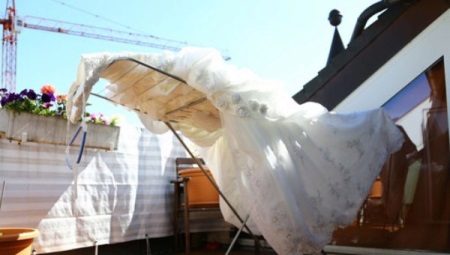
The wedding was celebrated, the gifts were opened, and it was time to think about cleaning the wedding dress. The celebration is fun, active, with a photo session in nature and dances, contests and toasts. No matter how you try to behave neatly at the wedding, you will not be able to avoid troubles. At the end of the celebration, in any case, you will have to put it in order. If you have a question about how best to wash a wedding dress and what products should be used, we will be happy to answer.
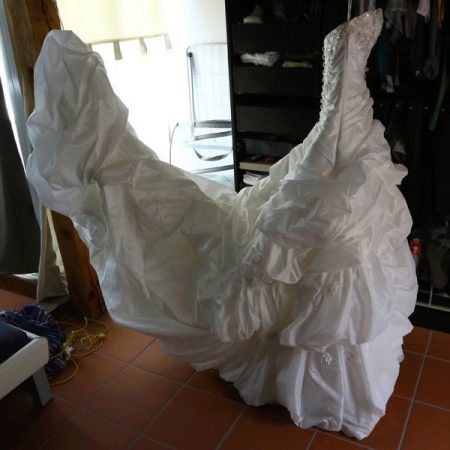
Hand wash
You can give a second life to a wedding dress yourself at home. An outfit that is dear to your heart requires special attention when washing and care must be taken with great care. That is why hand washing is considered to be of high quality.

Evaluate pollution
The first step is to familiarize yourself with the information indicated on the tag, and be sure to comply with all conditions. If there is a pictogram on it that prohibits cleaning at home, then the dress should be dry-cleaned. This also applies to stains that you cannot remove on your own.
See below for more details.
It is worth evaluating contamination before removing them begins. It is worth determining their nature and origin, stock up on the necessary tools that will help remove stains. Assess the condition of the hem - it is this part of the dresses that has the worst.
The choice of products and cleaning method depends on the fabric. Each has its own individual characteristics that need to be considered.
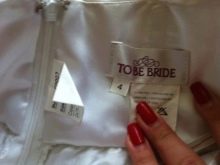
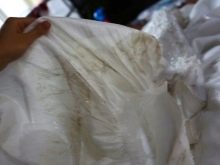
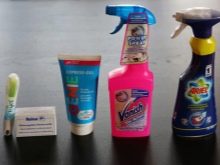
Partial soak
Partial soaking can only be carried out using a liquid product that is intended for use on delicate fabrics.When the required portion of the detergent is dissolved in warm water, you can soak only the dirtiest part of the dress, for example, the hem.
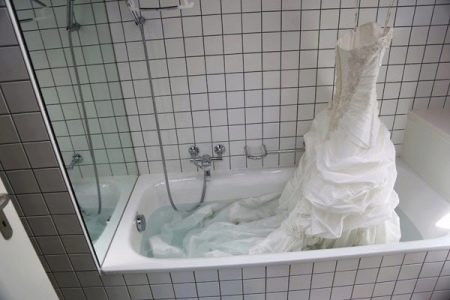
You will need a soft bristled toothbrush to help wipe away dirt. You need to rub without fanaticism, delicate fabrics do not like sudden movements.
Watch out for the lining, which is also often decently soiled. After such simple procedures, you can rinse the treated areas with clean water.
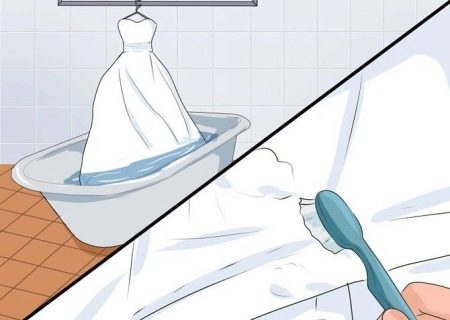
Fighting stains
Dealing with stains will not be a difficult process if you prepare for it in advance and follow some recommendations:
- sweat stains. Turn the dress over to the wrong side. Moisten the lining in the bodice with a pre-prepared soapy solution and wipe with a soapy sponge or, again, a soft-bristled toothbrush. If you have to deal with a silk dress, then sweat stains are removed from such a delicate material with the help of ordinary saline solution (a tablespoon of the most common salt falls into a glass of water). Carefully inspect the remaining lining and rub it with soapy water if it is dirty.
- Red wine. Now it's time to deal with the front of the dress. Red wine is removed by exposing it to hot soapy water.
- grass stains. Take 1 tbsp. warm water and 1 tsp. ammonia, mix and blot well. Lather dry area with laundry soap and wash.
If other spots were found, then you can choose three ways to deal with them:
- thorough but not vigorous wiping with a soapy sponge;
- using a concentrated detergent;
- treatment with an oxygen-based stain remover.
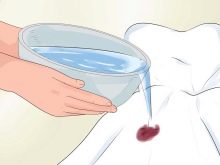
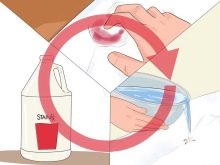

Main wash
The main wash should follow the following scenario:
- we collect warm water (30-40 degrees) into the bathroom or a large basin and dissolve the detergent in it without aggressive effects;
- put the dress in the bathroom for 2 hours;
- lightly rinse the dress in soapy water, paying special attention to places with particularly heavy dirt;
- rinse the dress in clean water until soap bubbles form in the water.
Dresses without heavy decorative elements, large accessories and embroidery can be washed while hanging. You will need a coat hanger, shower hose, and soapy water. You need to wash very carefully, not allowing the product to stretch and stretch in a certain direction.

Machine wash
In fact, washing in a machine can be used, although many people find this method ridiculous and even dangerous. With the right approach, machine wash can still make a dress as fresh and beautiful as it was originally:
- choose the most gentle and delicate mode without spinning and with a shortened cycle time;
- use only liquid and colorless detergent;
- so that the embroidery or bead decor does not lose its appearance, you can sew gauze on top;
- the use of a bulk bag for washing predominantly.
If there is a corset in the outfit, then at high temperatures and high rpm in washing, it can lose its structure. This can no longer be fixed.

A large amount of tulle and a lot of fluffiness in the skirt is the reason for using starch during washing. It can be poured into that compartment of the machine, which is intended for the air conditioner. Such a simple method will help to restore the original look of the dress and make it as presentable as it was before the wedding.
Washing the dress should not be put on the back burner, but start this process immediately on the second day.

Drying
The wash is complete, the dress is as good as new, it remains to dry the dress. It should be dried naturally. In no case should you squeeze out, so as not to break the fabric, not spoil the shape of the dress and leave the decor the same as it was originally.
If the dress does not have many layers, is not lush and not heavy, then it can be dried while hanging. If the dress is voluminous and has an impressive weight, then you need to allow the water to drain, placing it on a vinyl grate designed for drying clothes.
After the water has drained, the dress can be hung on a hanger and taken out into the fresh air. Carefully smooth the material along its entire length with a damp hand, excluding the presence of folds. During ironing, you will be grateful to yourself for this.
The dress should not be exposed to sunlight and should not be dried on a battery - in both cases it will turn yellow.
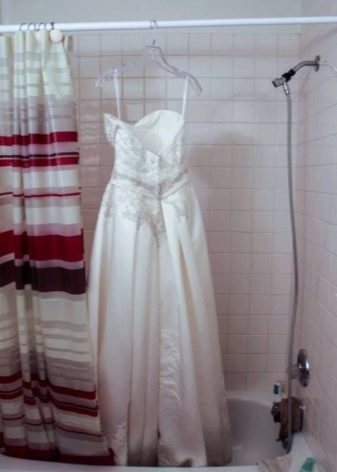
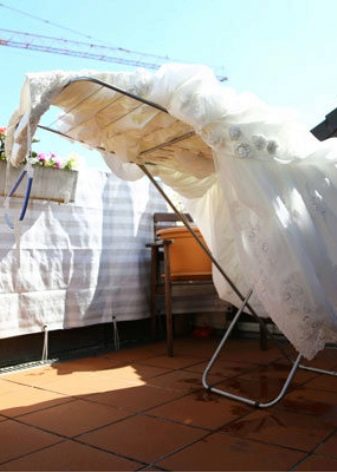
Ironing
Well, the important moment has come - ironing. If the dress is not ironed, it may remain wrinkled forever.
Iron only on a perfectly clean ironing board. Examine the surface of the iron as well - its cleanliness should leave no doubt.
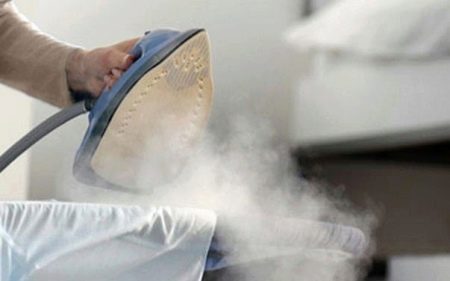
You should know the material from which the dress was sewn, as delicate fabrics require special ironing:
- the satin is ironed not from the front side, but from the seamy side. Steaming may leave traces of water;
- lace under the influence of high temperature can turn yellow or melt, so that this does not happen, it must be ironed through cotton. The iron should be operating in the silk steam ironing mode.
- light fabrics with a flying effect cannot be ironed at all, only steamed while hanging. Starting with the lining, it is necessary to steam each layer in turn.
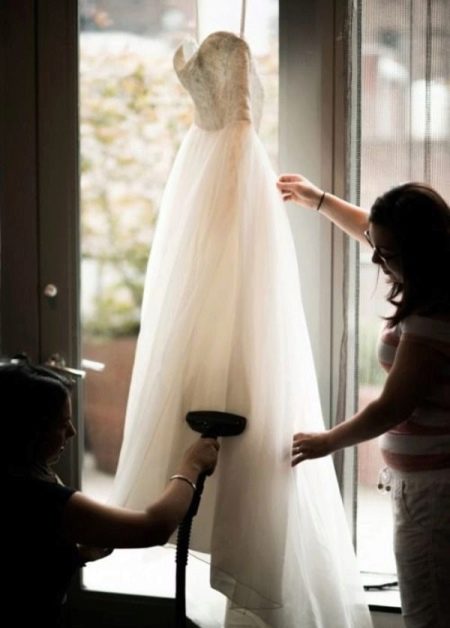
You will definitely succeed if you are patient and careful. Store the dress in a cover, folded in half. Periodically, it will need to be taken out and ventilated, plunging into happy memories at the same time.








If you are planning to sell a wedding dress, it is better not to risk it and have it dry cleaned.